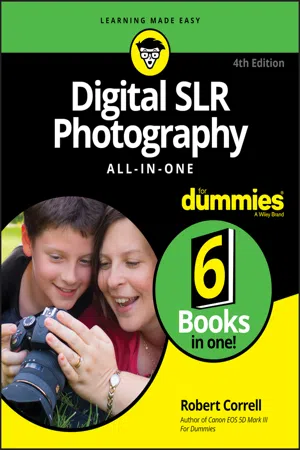
- English
- ePUB (mobile friendly)
- Available on iOS & Android
Digital SLR Photography All-in-One For Dummies
About This Book
Click your way to stunning digital images with thisthoroughresource!
With thesix mini-guides in Digital SLR Photography All-in-OneForDummies, you've gotthe six ingredients you need to cook up some fantastic photos.This book willhelp you make friends withyourdSLRwhetherit'sthe latestmodeloran olderhand-me-down. Together, you'll find the perfect angles, exposure, and lightingtocapturemagical images.
It wouldn't be digital photography without a bit of tech—SD cards, file transfers, resolution, and a few other things you might have never encountered before you picked up adSLR. With this book, you canbecome acamera-wrangler extraordinaire, getting your shots and using digital editing tools to help them looktheir best.Now you havethe tools you needto start building your portfolio—including some friendly advice on which images to include! Get out there and get shooting!
- Explore your camera's featuresandsettings, then pick theperfect lenses for your photography style
- Learn how to make beautiful imagesby controlling thekey components ofexposure--aperture, shutter speed, and ISOsettings
- Light your shots perfectlywith or withouta flash or other lighting equipment
- Use digital tools to make your photos shine and create an outstanding portfolio
Upgrading to a digital SLR is a sign that you're serious about becoming a better photographer.Let this chummy Dummies guide, well, guideyou as you become an image maker!
Frequently asked questions
Information
Pursuing Digital SLR Photography
Contents at a Glance
- Chapter 1: Embracing Digital SLRs
- Introducing the Digital SLR
- Naming and Classifying Digital SLRs
- Pricing Digital SLRs
- Delving into Camera Specifications
- Following Recent dSLR Developments
- Shopping for a dSLR
- Embracing dSLRs
- Chapter 2: Handling, Cleaning, and Protecting Your Camera
- Anatomy of a dSLR
- Working the Controls
- Gripping the Camera
- Providing Additional Support
- Handling an Articulated Monitor
- Using a Touchscreen
- Changing Batteries
- Inserting and Removing Memory Cards
- Cleaning Your Camera
- Protecting Your Camera
- Chapter 3: Learning about Lenses
- Identifying and Naming Lenses
- Categorizing Lenses
- Looking at Lens Anatomy
- Working with Lenses
- Cleaning Lenses
- Chapter 4: Exploring Menus and Camera Settings
- Understanding How Menus Are Organized
- Opening and Using the Menu
- Setting Up Your Camera
- Setting Typical Shooting Options
- Making Other Choices
- Controlling Playback
- Keeping Everything Running Smoothly
- Exploring Advanced Options
- Chapter 5: Taking Pictures with Your dSLR
- Seeing the Big Picture
- Planning Ahead
- Unpacking and Readying Your Gear
- Setting Up Your Camera
- Taking and Reviewing Photos
Embracing Digital SLRs





Introducing the Digital SLR

Naming and Classifying Digital SLRs
Make and model
- Nikon starts its dSLRs with the letter D (think digital), followed by a number. In general, the smaller the number, the more advanced and expensive the camera. For example, the D6 is currently Nikon’s premier professional camera. The D3500, on the other hand, is an entry-level consumer camera.
- Canon uses the acronym EOS (electro-optical system) followed by a model number to identify its digital SLRs. For example, the Canon EOS 90D is a mid-range model. Canon uses the term Rebel to identify its consumer dSLRs. The Rebels sport one of two model numbers, depending on the market they are sold in. For example, the EOS Rebel T8i is also known as the 850D. You may see it written as the EOS Rebel T8i/850D. Canon often identifies improved models by adding the term Mark and then a number, su...
Table of contents
- Cover
- Title Page
- Table of Contents
- Introduction
- Book 1: Pursuing Digital SLR Photography
- Book 2: Looking through Lenses
- Book 3: Taking Creative Control
- Book 4: Lighting the Scene
- Book 5: Managing and Processing Your Shots
- Book 6: Showcasing Different Scenes
- Index
- About the Author
- Connect with Dummies
- End User License Agreement